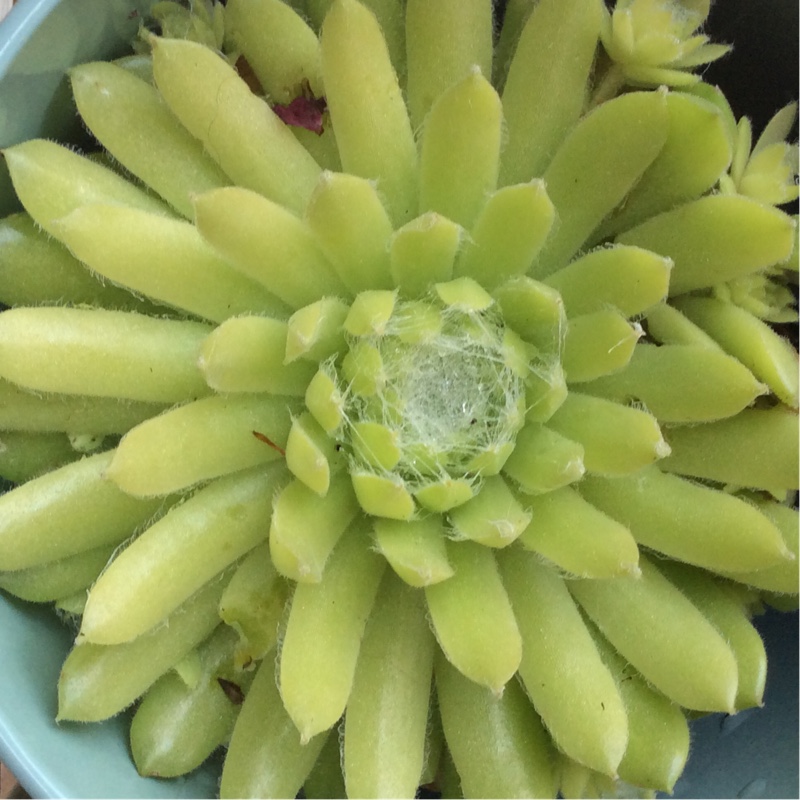
Sempervivum Spring Beauty
Sempervivum 'Spring Beauty'
'Spring Beauty' has medium-sized grey-green rosettes that turn plum-coloured in colder months. Sempervivums, also known as Houseleeks or Hens and Chicks, are succulent perennials that form rosettes of succulent leaves that will often spread fast to form mats. They tend to spread rapidly in favourable conditions via offsets and are valued as a ground cover for dry, sunny locations. Their ability to store water in their thick leaves allow them to live in sunny and rocky places through out mountains. Most are hardy to US zone 4, and will handle warm climates to about zone 8. Sempervivum grow as tufts of perennial but monocarpic rosettes. Each rosette propagates asexually by lateral rosettes or offsets. Typically, each plant grows for several years before flowering. The colour of the flowers is reddish, yellowish, pinkish, or seldomly, whitish. In Sempervivum, the flowers are actinomorphic (like a star) and have more than six petals. After flowering, the plant dies, usually leaving many offsets it has produced during its life. Sempervivums also make suitable plants for containers, and do well in breathable terracotta, concrete, and cement pots. They have also been known to grow in rock crevices, metal containers, succulent wreaths, roof shingles, and anywhere else that allows adequate root drainage.
Contributed by @krishnahairdo
-
Full sun to partial shade
-
Occasional watering
-
A little frost hardy: 32F (0°C)
-
Free draining and fertile
Common name
Sempervivum 'Spring Beauty'
Latin name
Sempervivum Spring Beauty
type
Succulent
family
Crassulaceae
ph
6.0 - 7.0 Acid - Neutral
Plant & bloom calendar
-
Best time to plant
full grown dimensions
 0.30 M
0.20 M
0.30 M
0.20 M
Sempervivum Spring Beauty
'Spring Beauty' has medium-sized grey-green rosettes that turn plum-coloured in colder months. Sempervivums, also known as Houseleeks or Hens and Chicks, are succulent perennials that form rosettes of succulent leaves that will often spread fast to form mats. They tend to spread rapidly in favourable conditions via offsets and are valued as a ground cover for dry, sunny locations. Their ability to store water in their thick leaves allow them to live in sunny and rocky places through out mountains. Most are hardy to US zone 4, and will handle warm climates to about zone 8. Sempervivum grow as tufts of perennial but monocarpic rosettes. Each rosette propagates asexually by lateral rosettes or offsets. Typically, each plant grows for several years before flowering. The colour of the flowers is reddish, yellowish, pinkish, or seldomly, whitish. In Sempervivum, the flowers are actinomorphic (like a star) and have more than six petals. After flowering, the plant dies, usually leaving many offsets it has produced during its life. Sempervivums also make suitable plants for containers, and do well in breathable terracotta, concrete, and cement pots. They have also been known to grow in rock crevices, metal containers, succulent wreaths, roof shingles, and anywhere else that allows adequate root drainage.
Propagation
From Early Spring TO Late Winter
Mostly Sempervivums propagate by sending out offshoots, which root and become independent of the parent plant as the connecting stolon withers. Offshoots can be moved once they have reached a sufficient size. The stolon should be cut off at approximately one-half inch from the base of the new plant. This encourages roots to develop at the base of the rosette instead of along the stolon. Push the stolon into the soil, leaving the baby to sit on top of the soil.
Planting
From Early Spring TO Early Spring
The three things to remember when growing them are that they prefer full to partial sun (conditions dependant), well drained soil, and occasional water. They can easily be grown in cracks in dry stone walls, hypertufa, troughs, rock gardens, or a poor soil area that does not hold water. Very sandy clay soil is ideal. They will live much longer if carelessly thrown on concrete and forgotten than they will if planted in rich, organic soil and well watered.














